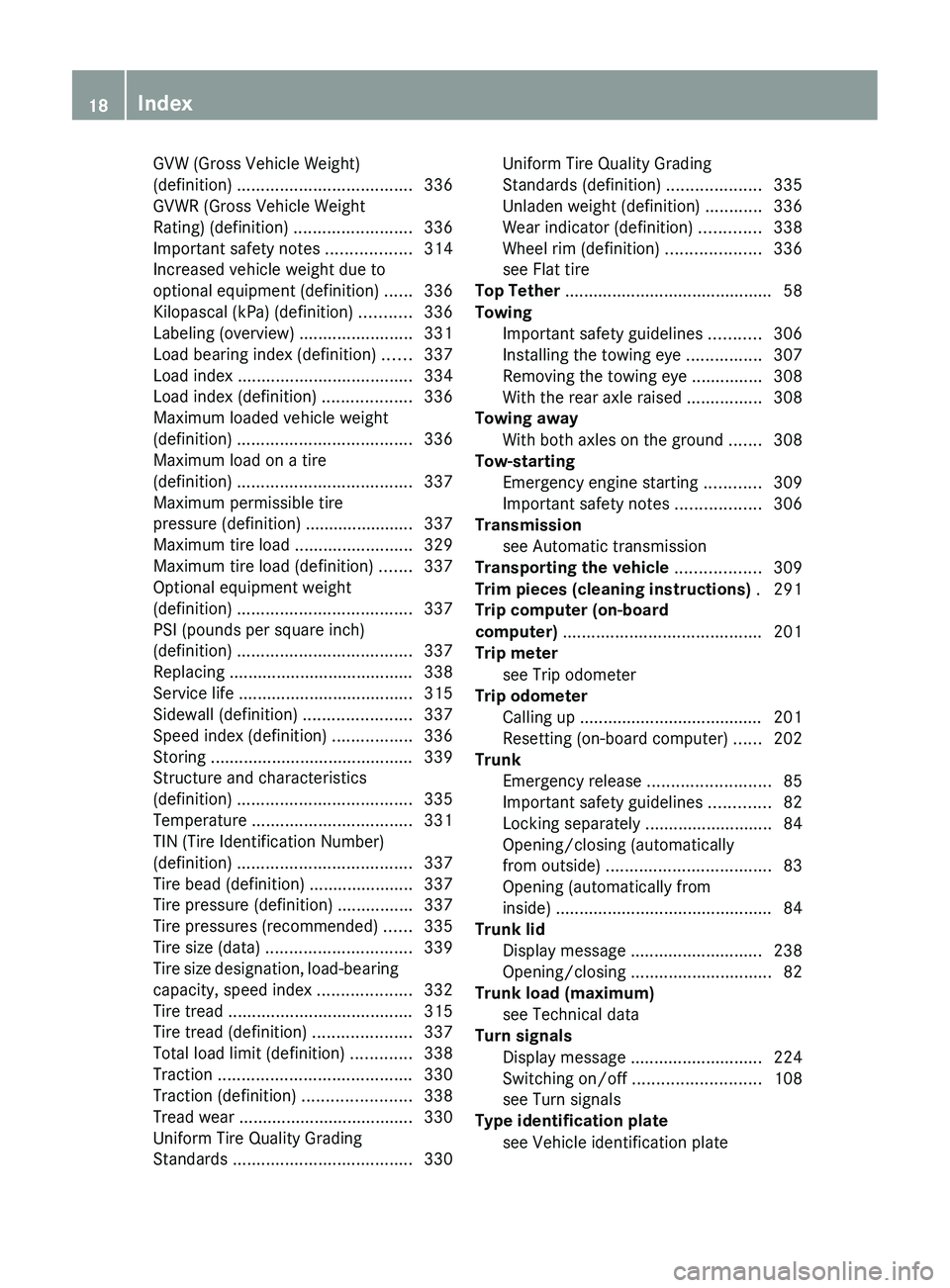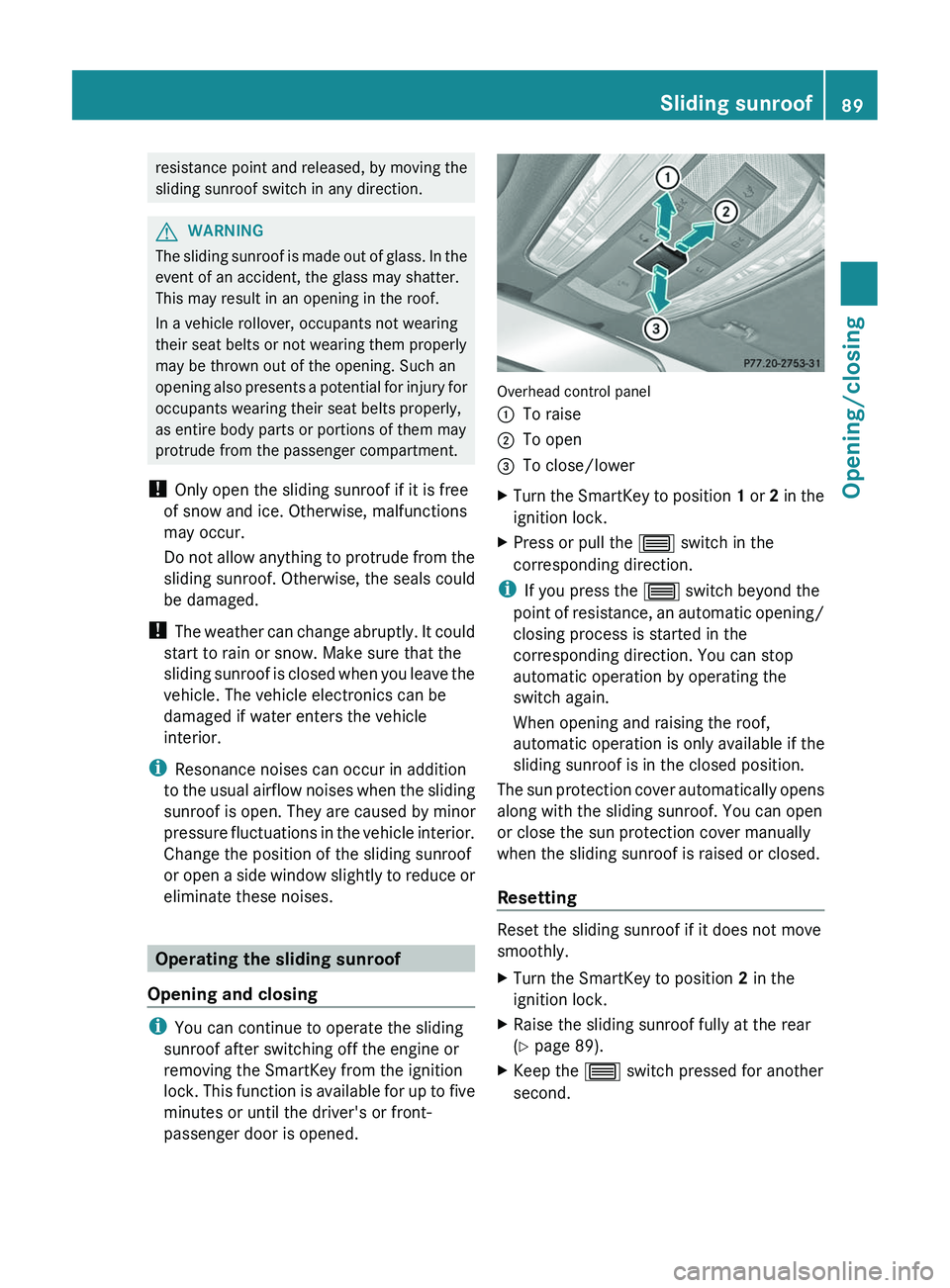tire pressure reset MERCEDES-BENZ CLS 2012 Owners Manual
[x] Cancel search | Manufacturer: MERCEDES-BENZ, Model Year: 2012, Model line: CLS, Model: MERCEDES-BENZ CLS 2012Pages: 356, PDF Size: 14.25 MB
Page 20 of 356

GVW (Gross Vehicle Weight)
(definition) ..................................... 336
GVWR (Gross Vehicle Weight
Rating) (definition) .........................336
Important safety notes ..................314
Increased vehicle weight due to
optional equipment (definition) ......336
Kilopascal (kPa) (definition) ...........336
Labeling (overview) ........................331
Load bearing index (definition) ......337
Load index ..................................... 334
Load index (definition) ...................336
Maximum loaded vehicle weight
(definition) ..................................... 336
Maximum load on a tire
(definition) ..................................... 337
Maximum permissible tire
pressure (definition) ....................... 337
Maximum tire load .........................329
Maximum tire load (definition) .......337
Optional equipment weight
(definition) ..................................... 337
PSI (pounds per square inch)
(definition) ..................................... 337
Replacing ....................................... 338
Service life ..................................... 315
Sidewall (definition) .......................337
Speed index (definition) .................336
Storing ........................................... 339
Structure and characteristics
(definition) ..................................... 335
Temperature .................................. 331
TIN (Tire Identification Number)
(definition) ..................................... 337
Tire bead (definition) ......................337
Tire pressure (definition) ................337
Tire pressures (recommended) ......335
Tire size (data) ............................... 339
Tire size designation, load-bearing
capacity, speed index ....................332
Tire tread ....................................... 315
Tire tread (definition) .....................337
Total load limit (definition) .............338
Traction ......................................... 330
Traction (definition) .......................338
Tread wear ..................................... 330
Uniform Tire Quality Grading
Standards ...................................... 330Uniform Tire Quality Grading
Standards (definition) ....................335
Unladen weight (definition) ............336
Wear indicator (definition) .............338
Wheel rim (definition) ....................336
see Flat tire
Top Tether ............................................ 58
Towing Important safety guidelines ...........306
Installing the towing eye ................307
Removing the towing eye ...............308
With the rear axle raised ................308
Towing away
With both axles on the ground .......308
Tow-starting
Emergency engine starting ............309
Important safety notes ..................306
Transmission
see Automatic transmission
Transporting the vehicle .................. 309
Trim pieces (cleaning instructions) . 291
Trip computer (on-board
computer) .......................................... 201
Trip meter see Trip odometer
Trip odometer
Calling up ....................................... 201
Resetting (on-board computer) ......202
Trunk
Emergency release ..........................85
Important safety guidelines .............82
Locking separately ...........................84
Opening/closing (automatically
from outside) ................................... 83
Opening (automatically from
inside) .............................................. 84
Trunk lid
Display message ............................ 238
Opening/closing .............................. 82
Trunk load (maximum)
see Technical data
Turn signals
Display message ............................ 224
Switching on/off ........................... 108
see Turn signals
Type identification plate
see Vehicle identification plate 18Index
Page 91 of 356

resistance point and released, by moving the
sliding sunroof switch in any direction.GWARNING
The sliding sunroof is made out of glass. In the
event of an accident, the glass may shatter.
This may result in an opening in the roof.
In a vehicle rollover, occupants not wearing
their seat belts or not wearing them properly
may be thrown out of the opening. Such an
opening also presents a potential for injury for
occupants wearing their seat belts properly,
as entire body parts or portions of them may
protrude from the passenger compartment.
! Only open the sliding sunroof if it is free
of snow and ice. Otherwise, malfunctions
may occur.
Do not allow anything to protrude from the
sliding sunroof. Otherwise, the seals could
be damaged.
! The weather can change abruptly. It could
start to rain or snow. Make sure that the
sliding sunroof is closed when you leave the
vehicle. The vehicle electronics can be
damaged if water enters the vehicle
interior.
i Resonance noises can occur in addition
to the usual airflow noises when the sliding
sunroof is open. They are caused by minor
pressure fluctuations in the vehicle interior.
Change the position of the sliding sunroof
or open a side window slightly to reduce or
eliminate these noises.
Operating the sliding sunroof
Opening and closing
i You can continue to operate the sliding
sunroof after switching off the engine or
removing the SmartKey from the ignition
lock. This function is available for up to five
minutes or until the driver's or front-
passenger door is opened.
Overhead control panel
:To raise;To open=To close/lowerXTurn the SmartKey to position 1 or 2 in the
ignition lock.XPress or pull the 3 switch in the
corresponding direction.
i If you press the 3 switch beyond the
point of resistance, an automatic opening/
closing process is started in the
corresponding direction. You can stop
automatic operation by operating the
switch again.
When opening and raising the roof,
automatic operation is only available if the
sliding sunroof is in the closed position.
The sun protection cover automatically opens
along with the sliding sunroof. You can open
or close the sun protection cover manually
when the sliding sunroof is raised or closed.
Resetting
Reset the sliding sunroof if it does not move
smoothly.
XTurn the SmartKey to position 2 in the
ignition lock.XRaise the sliding sunroof fully at the rear
( Y page 89).XKeep the 3 switch pressed for another
second.Sliding sunroof89Opening/closingZ
Page 157 of 356

Driving systems
Cruise control
Important safety notes
Cruise control maintains a constant road
speed for you. It brakes automatically in order
to avoid exceeding the set speed. On long and
steep downhill gradients, especially if the
vehicle is laden, you must select shift range
1 , 2 or 3 in good time. By doing so, you will
make use of the braking effect of the engine,
which relieves the load on the brake system
and prevents the brakes from overheating
and wearing too quickly.
Use cruise control only if road and traffic
conditions make it appropriate to maintain a
steady speed for a prolonged period. You can
set any road speed above 20 mph
(30 km/h).
GWARNING
The cruise control is a convenience system
designed to assist the driver during vehicle
operation. The driver is and must always
remain responsible for the vehicle's speed
and for safe brake operation.
Only use the cruise control if the road, traffic,
and weather conditions make it advisable to
travel at a constant speed.
R The use of the cruise control can be
dangerous on winding roads or in heavy
traffic because conditions do not allow safe
driving at a constant speed.
R The use of the cruise control can be
dangerous on slippery roads. Rapid
changes in tire traction can result in wheel
spin and loss of control.
R Deactivate the cruise control when driving
in fog.
The "Resume" function should only be
operated if the driver is fully aware of the
previously set speed and wishes to resume
this particular preset speed.
Cruise control lever:To store the current speed or a higher
speed;To store the current speed or a lower
speed=To deactivate cruise control?To store the current speed or to call up
the last stored speed
When you activate cruise control, the stored
speed is shown in the multifunction display
for five seconds. In the multifunction display,
the segments between the stored speed and
the maximum speed light up.
Storing and maintaining the current
speed
You can store the current speed if you are
driving faster than 20 mph (30 km/h).
XAccelerate the vehicle to the desired
speed.XBriefly press the cruise control lever
up : or down ; to the pressure point.XRemove your foot from the accelerator
pedal.
Cruise control is activated. The vehicle
automatically maintains the stored speed.
i Cruise control may be unable to maintain
the stored speed on uphill gradients. The
stored speed is resumed when the gradient
evens out. Cruise control maintains the
stored speed on downhill gradients by
automatically applying the brakes.
Driving systems155Driving and parkingZ